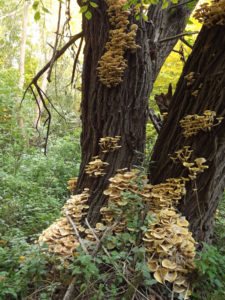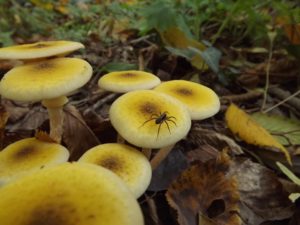Comparative genomics involving humongous fungus helps explain evolution of Armillaria

Clusters of fruiting bodies emerge on and around trees in Armillaria-infected areas in the fall. (Virág Tomity)
Among the contenders for the world’s largest living organism is something usually considered much smaller than a blue whale, or a towering sequoia. This particular organism is so big, one needs an aerial map to grasp its size, and even then it’s not completely visible as most of it is underground. It’s a specimen of the fungus Armillaria ostoyae, first discovered two decades ago though thought to be a few millennia old by then, and so large it is spread over nearly four square miles – a space equivalent to one-sixth of Manhattan, or nearly 8,300 Olympic-sized swimming pools – and weighs as much as three blue whales combined.
Sheer size aside, Armillaria fungi dominate in an entirely different category: they are among the most devastating fungal pathogens, causing root rot disease in more than 500 plant species found in forests, parks and vineyards. As white rot fungi, they are capable of breaking down all components of plant cell walls – cellulose, hemicellulose and lignin – a capability that interests bioenergy researchers looking for methods to cost-effectively convert plant biomass into alternative fuels. Reported in the October 30, 2017 issue of Nature Ecology & Evolution, an international team led by László G. Nagy of the Biological Research Center at the Hungarian Academy of Sciences and including researchers at the U.S. Department of Energy Joint Genome Institute (DOE JGI), a DOE Office of Science User Facility, sequenced and analyzed four Armillaria fungi, including A. ostoyae, and then compared these genomes with those of related fungi to better understand the evolution of Armillaria’s abilities to spread and infect, and effectively break down all components of plant cell walls.
“Armillaria species are some of the most devastating forest pathogens, responsible for forest decline in many temperate regions. There is thus a considerable interest in developing strategies against Armillaria spp, towards which understanding how they function in nature might be the first step,” said study senior author Nagy. “We are interested in how Armillaria use plant cell wall degrading enzymes (PCWDEs) when confronted with potential host plants.”
Affecting forest composition and carbon cycling
According to study co-author James Anderson from the University of Toronto, Armillaria species are extremely common in northern temperate forests and have nearly identical fruit-body morphology but different lifestyles. For example, A. gallica is primarily a degrader of hardwood and is not a pathogen of conifers. In contrast, A. ostoyae can be a highly aggressive root-rot pathogen of firs, pines, and other conifers, causing up to 100 percent mortality of conifer seedlings.
“Both of these fungi have a major effect on the composition of forest tree species and on carbon cycling,” said Igor Grigoriev, DOE JGI Fungal Program Head and a co-author on the study. “Both can help us better understand mechanisms of lignocellulose degradation. Moreover, these were among the first representatives of Physalacriaceae family and sequenced as a part of the DOE JGI’s 1000 Fungal Genomes initiative to produce reference genomes from each of more than 500 recognized families of fungi to fill in gaps in the Fungal Tree of Life.”

The fruiting bodies of Armillaria mellea, better known as honey mushrooms, around infected trees. Armillaria fungi are aggressive pathogens that can spread from tree to tree under the soil surface to harvest their materials for food. (Virag Tomity)
Aside from A. ostoyae, the team also sequenced and analyzed the genomes of A. cepistipes, A. gallica and A. solidipes. These genomes were then compared against 22 fungal genomes, many previously sequenced and annotated by the DOE JGI. They cataloged 20 gene families related to pathogenicity in the fungi, and identified enriched PCWDE families, the better to efficiently break down and access nutrients in dead wood. To help explain the unusually large fungal genomes in the Armillaria genus, they also found duplicated genes, suggesting Armillaria evolved primarily through gene family expansion and not transposable elements or “jumping genes.” The Armillaria fungal genomes are all available on the DOE JGI fungal genomics portal MycoCosm, along with the fungal genome sequences used for comparison.
Evolution of multicellularity
Nagy also pointed out that the research also sheds light on one of the long-standing questions in biology: the evolution of multicellularity. “Our comparative genomics and RNA-Seq data suggest that the development of rhizomorphs – shoestring-like structures that spread through the substrate in search for new food sources and can cross several feet underground – have a lot in common with that of fruiting bodies – both being complex multicellular structures,” he said. Click here to learn more in a complementary Nature Ecology & Evolution blog post.
Just as well-organized teams can accomplish more than even talented individuals, the evolution of multicellularity is of great interest because multicellular organisms can carry out functions beyond the reach of single cells. In addition, A. ostoyae’s collection of plant biomass-degrading enzymes could provide candidates for use with bioenergy feedstocks to generate biofuels and bioproducts that would be difficult to generate economically using more conventional approaches.
Collaborators on this project included researchers at: University of Sopron (Hungary); Swiss Federal Research Institute WSL (Switzerland); Technische Universität München (Germany); Maynooth University (Ireland); Seqomics Ltd (Hungary); University of Vienna (Austria); Ohio State University; University of Szeged (Hungary); Functional Genomics Center, ETH and University of Zurich (Switzerland); and, Helmholtz Zentrum München (Germany).